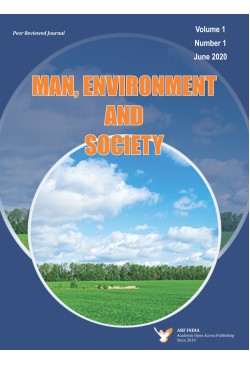
Man, Environment and Society
Frequency :Bi-Annual
ISSN :2582-7669
Peer Reviewed Journal
IN-BETWEEN SOUND AND LANDSCAPE: INTERCOMMUNITY INNOVATIONS AND SUSTAINABILITY THROUGH DREE FESTIVAL AMONG THE APATANI PEOPLE OF ARUNACHAL PRADESH
SOCIO-ECOLOGICAL IMPACT OF COAL MINING: A STUDY IN MOLUNGKIMONG VILLAGE, NAGALAND
FACTORS IMPACT ON POPULATION AND ENVIRONMENT IN BANGLADESH AND INDIA
CLIMATE CHANGE AND EVERYDAY-LIFE: NEGOTIATION OF WOMEN IN THE SUNDARBANS, INDIA
SELF-REPORTED INDUSTRIAL ACCIDENTS AND A SAFETY CLIMATE ANALYSIS OF A FOOD MANUFACTURING COMPANY IN NIGERIA
BAMBOO BASKET OF KABUI: TECHNO-FUNCTIONAL, SOCIAL AND AESTHETIC SIGNIFICANCES
SOCIAL AND CULTURAL BELIEFS ASSOCIATED WITH MENARCHE: A CASE STUDY AMONG THE AHOM
SELECTION INTENSITY AND ITS OPPORTUNITY AMONG SONOWAL KACHARI WOMEN OF DIBRUGARH DISTRICT, ASSAM
BLOOD PRESSURE IN RELATION TO BODY MASS INDEX AMONG THE MONPA: ALTITUDINAL DIFFERENCE
COMPOSITE INDEX OF ANTHROPOMETRIC FAILURE (CIAF) AMONG JUANG CHILDREN AND ADOLESCENTS OF KEONJHAR DISTRICT IN ODISHA, INDIA
Background: Assessment of the overall nutritional status among children by CIAF is an important technique. For achieving the goal of sustainable development, CIAF stands concrete evidence of the real picture of undernutrition.
POLITICAL REALITY OF RURAL WEST BENGAL IN COVID-19 LOCKDOWN: CHALLENGING HUMAN RIGHTS
USE OF MOBILE TECHNOLOGY FOR THE ACHIEVEMENT OF SDG GOALS RELATED TO MATERNAL HEALTH
Context: Bihar aims to achieve a maternal mortality ratio (MMR) of less than 70 per 1, 00, 000 live births, towards achieving its Sustainable Development Goal. The same can be achieved through robust monitoring of the health programs in the state. The present study critically analyses the use of a mobile-based reporting system on achieving the SDG for the state. Aims: The study aims to assess the use of mobile phone-based reporting systems for Sustainable Development Goals. Thus, establishing the usefulness of a mobile-based reporting system. The study also explores the cost of running the project.
Settings and Design: It is a quasi-experimental design. The study was conducted with Front Line Workers (FLW -Accredited Social Health Activist & Auxiliary Nurse Midwife) of two intervention blocks in the Saharsa District of Bihar. The two blocks were using mobile phones for reporting RMNCHA services. A total of 109 FLWs were contacted in Jul 2017.
THE DIFFERENTIAL ECONOMIC BENEFITS OF RURAL ELECTRIFICATION IN INDIA: QUANTILE REGRESSION ESTIMATION
IMPLICATIONS OF RIGHT TO EDUCATION ACT ON SCHOOL EDUCATION SYSTEM: A STUDY IN THE SCHOOLS OF LAMMASINGI TRIBAL VILLAGE OF
VISAKHA AGENCY, ANDHRAPRADESH
RELIGIOUS PRACTICES OF THE TEMPLES IN ANCIENT EGYPT AND PURI SHRI JAGANNATH TEMPLE IN INDIA: COMPARATIVE OVERVIEW